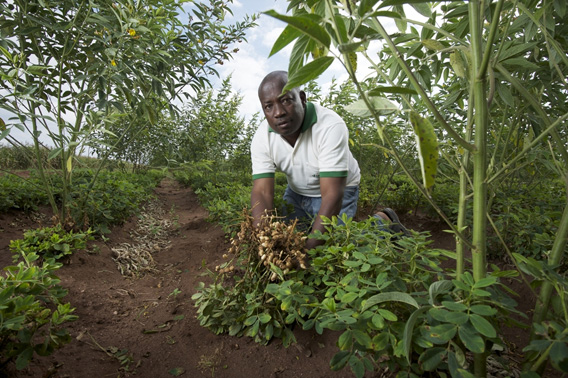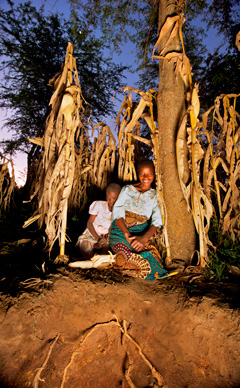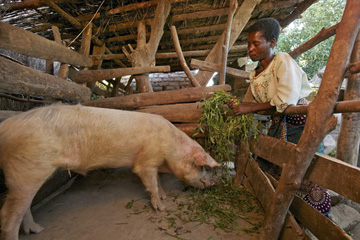
Groundnut breeder Albert Chamango grows tall perennial pigeon peas alongside his low-growing legumes to increase crop yields. Chamango works with the International Crops Research Institute for the Semi-Arid Tropics in Malawi. Photo credit: Jim Richardson.
It sounds counter-intuitive: Grow more food by planting less. But it’s a plan that scientists think will produce enough crops to feed Africa’s quickly expanding population. African farmers who sow food crops mixed with plants called perennials—which live two years or more—can enrich nutrient-poor soils and increase their bounty, argue scientists in the Sept. 20 issue of Nature.
Increasing food production is critical in Africa, said soil scientist John Reganold of Washington State University, an author of the article. “One-quarter of the world’s undernourished population is in sub-Saharan Africa,” he told mongabay.com. That number is only expected to grow, putting a further strain on farmers.
 Rhoda Mang’yana of Malawi is one of thousands of African farmers practicing “perenniation,” growing trees and annual crops that stay in the ground two years or more to improve depleted soil. Here she is with “fertilizer trees” that improve her crop yield and soil fertility. Photo by Jim Richardson. |
African farmers typically remove more nutrients from the soil than they put back. “The big challenge is: How do you restore the soils and get food?” said Reganold, referring to farmers who can’t afford to stop growing staple crops like maize, millet, groundnuts and sorghum. The scientists’ answer was perennials.
Planting perennials like trees and pigeon peas, side-by-side with a farmer’s regular crop, enriched soils gradually without leaving stomachs empty. Over time, the researchers claimed, this “perenniation” was a sustainable option because it tripled yields for maize in four to five years, increased the harvest of other staple crops and reduced the need for fertilizers.
Since perennials grow over many years, they tend to develop longer roots than surrounding crops. These roots reach water and nutrients deep in the earth, helping plants withstand harsh droughts and preventing precious topsoil from washing away with heavy rains. The roots and falling leaves of perennials add nutrients to the soil, such as nitrogen and carbon. All this creates more food to eat.
“We have enough information now that we know these systems work,” said Reganold, who has worked in Malawi to track how farmers incorporate perennials.
African farmers who use this approach reap a number of other benefits, the researchers have observed. Those who plant trees can use them as firewood. Pigeon peas are chock full of protein and important nutrients. Sprinkling in other perennials can control pests that normally reduce crop yields.
 Rhoda Mang’yana feeds her pigs maize bran, Gliricidia branches and weeds that grow in the fields. She sells the pigs to pay her grandchildren’s school fees. Photo by Jim Richardson. |
“These are the sweet spots; these are the things that can feed people but also use resources more efficiently,” said agronomist Sieglinde Snapp of Michigan State University, who was not part of the team. Snapp has been studying the mingling of perennial pigeon peas with staple food crops in Malawi, where children’s health has improved dramatically.
Farmers unfamiliar with growing perennials must learn a few new techniques—but they see the benefits, Snapp told mongabay.com. “To see your kids being more healthy, that makes people do the extra work that these systems take,” she said.
The extra investment has another big payoff, said Dennis Garrity, director of the World Agroforestry Centre (WAC), headquartered in Kenya: “Once the trees are established, they provide their goods and services for decades.”
Reganold hopes more farmers can adopt these principles. For example, the WAC now actively promotes perennials in Africa. The organization intends to plant millions of trees over the next few years in Ethiopia, Rwanda, Burundi, and Uganda, said Reganold.
The new approaches have given scientists and organizations “ways to move forward when we think about food security for the coming decades,” said Snapp, “but also in an environmentally friendly way.”
CITATION: Jerry D. Glover, John P. Reganold, and Cindy M. Cox. Plant perennials to save Africa’s soils. Nature, 20 September 2012. DOI: 10.1038/489359a
Ryder Diaz is a graduate student in the Science Communication Program at the University of California, Santa Cruz.
Related articles